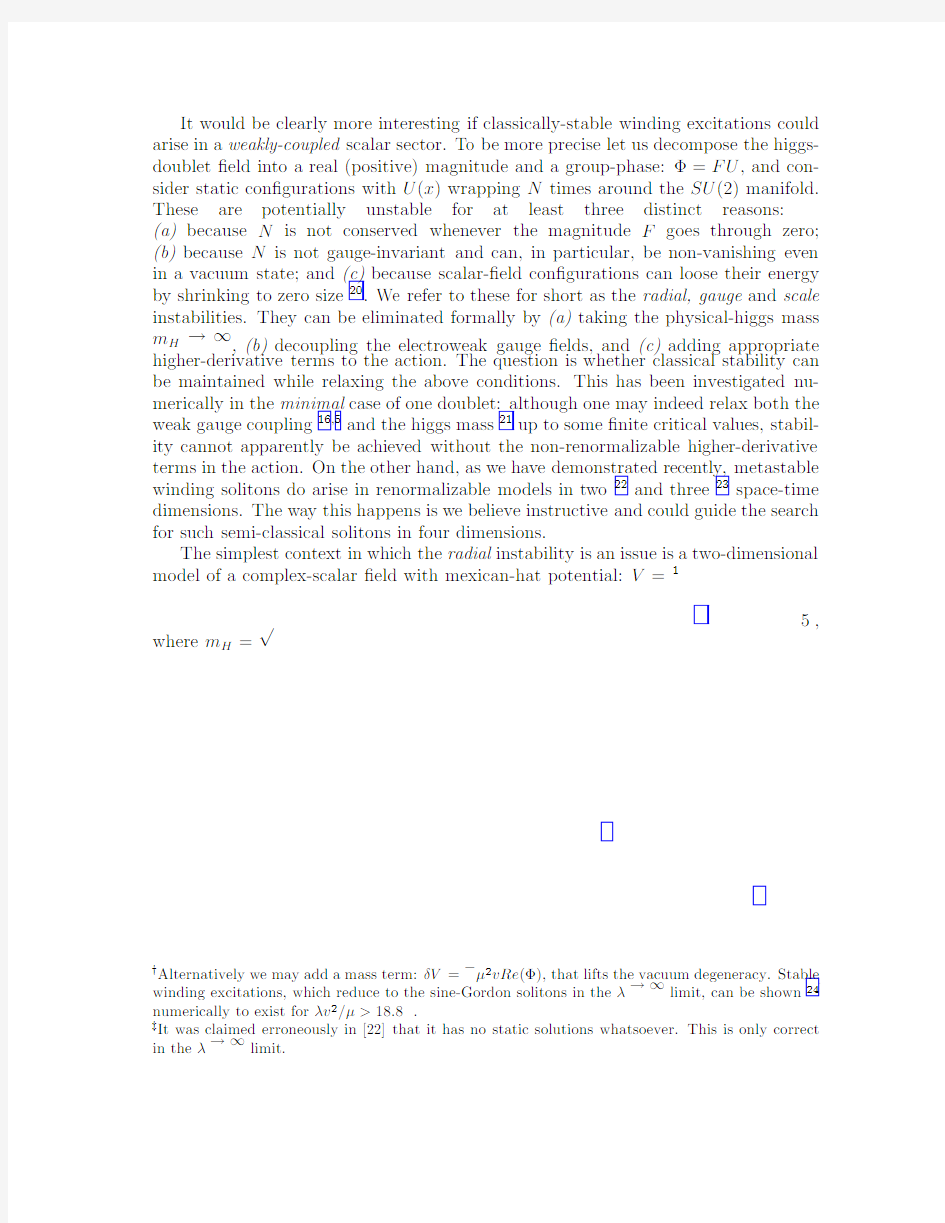

a r
X
i
v
:h e
p
-
p
h
/
9
5
1
2
6
4v
1
1
1
J
a
n
1
9
9
5
ARE THERE SOLITONS IN THE TWO-HIGGS STANDARD MODEL??C.P.BACHAS Centre de Physique Th′e orique Ecole Polytechnique 91128Palaiseau,France and T.N.TOMARAS Physics Department,University of Crete and Research Center of Crete 71409Heraklion,Greece ABSTRACT We present some evidence,based on the analysis of lower-dimensional models,for the possible existence of classically-stable winding solitons in the two-higgs elec-troweak theory.The search for stable lumps in the Weinberg-Salam model has a long history.It has revealed a rich structure of classical solutions including the sphaleron 1,2,3,4,deformed sphalerons 5,6,7,8and vortex strings 9,10,11,12,13.Such solutions could play a role in understanding (B+L)-violation and structure formation in the early universe,but they are all classically-unstable or/and extended.They have therefore no direct present-day manifestation,contrary to long-lived particles whose relic density could
at least in principle be detected.
The existence of particle-like excitations has,on the other hand,been argued for in the context of a strongly-interacting higgs sector 14,15,16,17,18.The advocated particles can be thought of as technibaryons of an underlying technicolor model.They are described in bosonic language by winding solitons of an e?ective non-renormalizable lagrangian for the pseudo-goldstone-boson (or technipion)?eld,much like skyrmions 19of the e?ective chiral lagrangian of QCD .This is of course a phenomenological description,since the properties of such hypothetical particles cannot be calculated reliably within a semi-classical expansion.Furthermore,in view of the di?culties facing technicolor models,the possibility of a strongly-interacting higgs sector is not theoretically appealing.
It would be clearly more interesting if classically-stable winding excitations could arise in a weakly-coupled scalar sector.To be more precise let us decompose the higgs-doublet?eld into a real(positive)magnitude and a group-phase:Φ=F U,and con-
sider static con?gurations with U(x)wrapping N times around the SU(2)manifold. These are potentially unstable for at least three distinct reasons:
(a)because N is not conserved whenever the magnitude F goes through zero;
(b)because N is not gauge-invariant and can,in particular,be non-vanishing even in a vacuum state;and(c)because scalar-?eld con?gurations can loose their energy
by shrinking to zero size20.We refer to these for short as the radial,gauge and scale instabilities.They can be eliminated formally by(a)taking the physical-higgs mass m H→∞,(b)decoupling the electroweak gauge?elds,and(c)adding appropriate higher-derivative terms to the action.The question is whether classical stability can
be maintained while relaxing the above conditions.This has been investigated nu-merically in the minimal case of one doublet:although one may indeed relax both the weak gauge coupling16,5and the higgs mass21up to some?nite critical values,stabil-ity cannot apparently be achieved without the non-renormalizable higher-derivative terms in the action.On the other hand,as we have demonstrated recently,metastable winding solitons do arise in renormalizable models in two22and three23space-time dimensions.The way this happens is we believe instructive and could guide the search for such semi-classical solitons in four dimensions.
The simplest context in which the radial instability is an issue is a two-dimensional
model of a complex-scalar?eld with mexican-hat potential:V=1
5,√
where m H=
?Alternatively we may add a mass term:δV=?μ2vRe(Φ),that lifts the vacuum degeneracy.Stable winding excitations,which reduce to the sine-Gordon solitons in theλ→∞limit,can be shown24 numerically to exist forλv2/μ>18.8.
?It was claimed erroneously in[22]that it has no static solutions whatsoever.This is only correct in theλ→∞limit.
The scale instability becomes an issue for the?rst time in three space-time di-mensions.To be more precise we consider a real-triplet scalar?eldΦa(x)(a=1,2,3) with mexican-hat potential:V=1
§Though admittedly premature,some other physical properties of such would-be particles are fun to contemplate:being classically stable they could easily have cosmological life times.They would have a mass in the~10T eV region,zero charge and dipole moments in their ground state,and geometrical interaction cross sections of order1/m2W.Assuming maximum production at the elec-troweak phase transition,a rough estimate of their present abundance shows that they could be candidates for cold dark matter in the universe.
4.J.Boguta,Phys.Rev.Lett.50(1983)148;
J.Burzla?,Nucl.Phys.B233(1984)262.
5.G.Eilam,D.Klabucar and A.Stern,Phys.Rev.Lett.56(1986)1331;
G.Eilam and A.Stern,Nucl.Phys.B294(1987)775.
6.J.Kunz and Y.Brihaye,Phys.Lett.B216(1989)353and B249(1990)90.
7.L.Ya?e,Phys.Rev.D40(1989)3463.
8.F.Klinkhamer,Phys.Lett.B236(1990)187.
9.Y.Nambu,Nucl.Phys.B130(1977)505.
10.M.B.Einhorn and R.Savit,Phys.Lett.B77(1978)295;
V.Soni,Phys.Lett.B93(1980)101;
K.Huang and R.Tipton,Phys.Rev.D23(1981)3050.
11.T.Vachaspati,Phys.Rev.Lett.68(1992)1977
and Nucl.Phys.B397(1993)648;
T.Vachaspati and M.Barriola,Phys.Rev.Lett.69(1992)1867.
12.M.James,T.Vachaspati and L.Perivolaropoulos,Phys.Rev.D46(1992)
R5232and Nucl.Phys.B395(1993)534.
13.L.Perivolaropoulos,Phys.Lett.B316(1993)528;
M.Earnshaw and M.James,Phys.Rev.D48(1993)5818.
14.J.M.Gipson and H.C.Tze,Nucl.Phys.B183(1981)524;
J.M.Gipson,Nucl.Phys.B231(1984)365.
15.E.D’Hoker and E.Fahri,Nucl.Phys.B241(1984)104,and
Phys.Lett.134B(1984)86.
16.V.A.Rubakov,Nucl.Phys.B256(1985)509;
J.Ambjorn and V.A.Rubakov,Nucl.Phys.B256(1985)434.
17.R.MacKenzie,F.Wilczek and A.Zee,Phys.Rev.Lett.53(1984)2203;
R.MacKenzie,Mod.Phys.Lett.A7(1992)293.
18.J.W.Carlson,Nucl.Phys.B253(1985)149,and B277(1986)253.
19.T.H.R.Skyrme,Proc.Roy.Soc.(London),Ser.A260(1961)127.
20.G.H.Derrick,J.Math.Phys.5(1964)1252.
21.Y.Brihaye,J.Kunz and F.Mousset,Z.Phys.C56(1992)231;
J.Baacke,G.Eilam and https://www.doczj.com/doc/c54798853.html,nge,Phys.Lett.B199(1987)234.
22.C.Bachas and T.N.Tomaras,Nucl.Phys.B428(1994)209.
23.C.Bachas and T.N.Tomaras,CPTH-A323.0794and Crete-94-14preprint
(September1994).
24.K.Pallis,U.of Thessaloniki undergraduate thesis(1994).
25.Y.Brihaye,S.Giller,P.Kosinski and J.Kunz,Phys.Lett.B293(1992)383.
26.A.A.Belavin and A.M.Polyakov,JETP Lett.22(1975)245.
27.R.A.Leese,M.Peyrard and W.J.Zakrzewski,Nonlinearity3(1990)773.
28.Y.Brihaye,J.Kunz and C.Semay,Phys.Rev.D42(1990)193;
Phys.Rev.D44(1991)250,and references therein.
29.A.Dobado and J.J.Herrero,Nucl.Phys.B319(1989)491,and references
therein.
30.B.Kastening,R.D.Peccei and X.Zhang,Phys.Lett.B266(1991)413.
31.C.Bachas,P.Tinyakov and T.N.Tomaras,work in progress.